Frank
E. Coulter
Harp Guitars
and Other Stringed Instruments
by Gregg Miner
July, 2013
Updated August, 2013
|
After creating three separate blogs on Coulter - almost one for each harp guitar discovery - after the fifth, I decided I had better give this obscure Portland, Oregon historical maker his own page! At right are Coulter's known harp guitars (so far) in the order of their discovery. Below, you'll find additional details on these, plus many of his other strange stringed instruments, along with rare historical photos - and even an original catalog! |
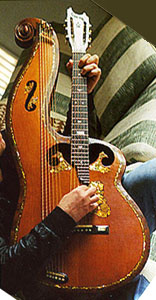 |
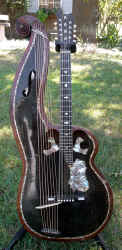 |
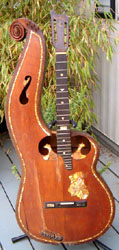 |
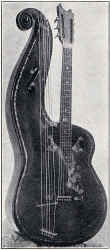 |
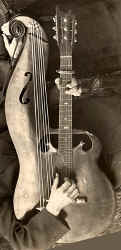 |
|
Coulter, of which two photos are now known, remains somewhat of an enigma. Only recently have people started to pay attention to his curious and distinctive instruments, while only one or two bits of rather bizarre biographical material have shown up on the Internet. Here’s a rare and strangely fascinating interview with Coulter from 1939. Even more interesting is this 1937 piece in "Everybody's Business." |
||
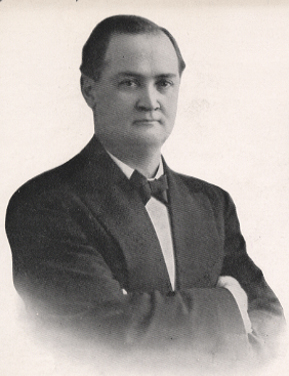 |
He seems to have been actively building in Portland, Oregon from the 1910s into the 1920s, though a 1939 repair label one of his own mandolins shows that he was still working on instruments up until that time. Personally, I think Coulter's unique passion and specialty is summed up in the final line of his labels, offering “Odd instruments to order.” |
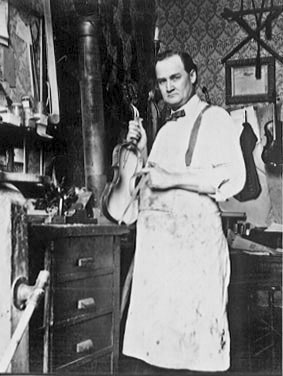 |
| I
learned of Coulter many years ago from John Doan and Kerry Char. John owns
an unusual mando-cello by Coulter, while Kerry owns various guitars and
mandolins.
Years ago, the owner of an unusual Coulter harp guitar – Gordon Anderson (shown in 2000 at age 48 with the harp guitar, at right) – shared the family’s treasure with John. It was custom ordered from Coulter by Gordon’s grandfather, Leroy – shown below at around age 20 with his brand new harp guitar and then (next photo) late in life with the well-preserved instrument. |
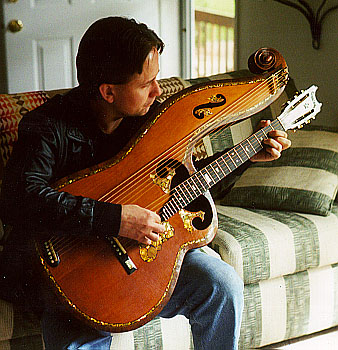 |
|
| Gordon once did some research on Coulter at the Historical Society and
discovered that Coulter “was a pastor, made an unsuccessful bid for the
Oregon State Senate, and stumbled into luthiery repairing church violins
and such.” Coulter was clearly interested in gaudier decoration, and
the instruments are said to be a bit crude, but are nevertheless fascinating
designs. This harp guitar has 6 subs with zither pin tuners.
It’s currently in the possession of Gordon’s uncle.
Old newspaper listing courtesy of Gordon Anderson |
||
| In 2011, a second Coulter harp guitar turned up. Note that it has 12 strings on the neck! It also has 7 sub-basses, as opposed to the 6 of Anderson's above. | 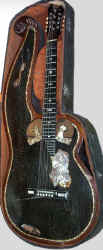 |
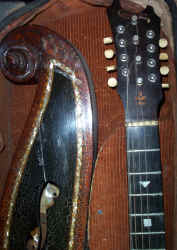 |
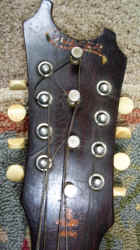 |
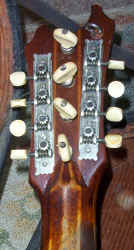 |
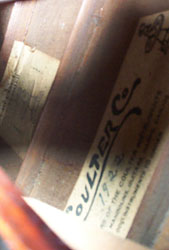 |
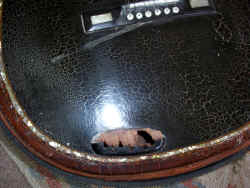 |
| Though it was certainly a rare and interesting harp
guitar, it was not a project I wanted to take on, so the owner
eventually eBayed it. The lucky auction winner and brave
individual was John Riley, from Newnan, GA, who had previously
acquired and restored both a Wishnevsky and a Gibson harp guitar.
John shared his experience “real time” on our Forum here, and completed the project in September, 2012. At right is the result. John provided these specs and comments: “The Coulter is 42” long, with a 17” lower bout and a body thickness of 4”. The scale of the neck is 24.75”. This compares pretty well to my Gibson (45” x 19” x 3.5”, same neck scale). The big difference is weight! The Coulter weighs a scant 7 lbs, as opposed to 12 lbs. for the Gibson!” John also describes it as “loud!” |
 |
 |
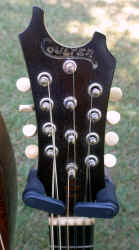 |
 |
| Meanwhile, John Riley (owner of #2) had contacted a great-granddaughter
of Coulter, Jane Sanford Harrison, who wrote, “My great-grandfather was
quite a character, by all reports (he died a year after I was born) –
extremely opinionated, and apparently very individual in the way he built
instruments.” Because of John’s queries, she went digging in the
family archives and found this remarkable Coulter heirloom – an original
brochure! Thanks to Jane for kindly sharing this important document
with us. Lucky for us, it includes a harp guitar. This one (specimen #4) has a dark-ish top with a 6-string neck and 6 sub-basses. But this is interesting...compare this grainy, black and white image with the cleaned up specimen #3 above. The fingerboard inlays seem to match exactly (when the others are more random). Ignoring the light colored areas of (???) around the end of the fb, the shell inlay pieces even seem to match shape...or am I crazy? Could this be the very same instrument? Coulter mentions “six to twelve contra bass strings,” implying that he knows that that’s how harp guitars were typically configured, and that he offers same (the harp guitar above has 7 subs). Below, I will include the complete brochure and its line-up of illustrated instruments. |
| Now on to Coulter's many other fretted instruments (but
often with strange inlaid, fretless necks). First the
catalog.
The most interesting historical finding in the undated 8-page brochure may well be Coulter’s own introduction to the whys and wherefores of his unusual construction techniques. He is not lacking in self-confidence! Next we see all of his “standard” models. Note the perfectly circular shape of his mandolins and Style B guitar and the opposing off-center soundholes at the soundboard’s top. These represent some of his key “improvements.” At the close, Coulter shares his motto, which concerns “great instruments (being the) “product of great loves and the individual efforts of passion driven men.” |
||
|
A few interesting catalog observations: Coulter offers a very specific set of mandolin family instruments; in fact, he is one of the very few to list the entire set. Besides mandolin (or his “Super Mandolin”), he lists Piccolo, Tenor Mandola, Octave Mandola, ‘Cello Mandola and a “Double Mandola Bass.” Most have scale length listed, along with body diameter and depth. |
||
| Another spectacular "odd instrument to order" was made by
Coulter, as described in the Dec
31, 1927 Music Trade Review. It's a greatly enlarged, playable
"Montana banjo" with a 28" head and a reported 9 foot
long neck! That's obviously an error - the scale works out to less
than six feet when analyzed. Perhaps the entire instrument was 9'
high.
Either way, it's quite an accomplishment and a pretty fitting instrument (Coulter's last?) for the creative Mr. Coulter! |
|
If you enjoyed this article, or found it useful for research, please consider making a donation to The Harp Guitar Foundation, which supports Harpguitars.net so that this information will be available for others like you and to future generations. Thank you for your support! |
|
|
|
All Site Contents Copyright © Gregg Miner, 2004,2005,2006,2007,2008,2009,2010,2011,2012,2013. All Rights Reserved. Copyright and Fair Use of material and use of images: See Copyright and Fair Use policy. |